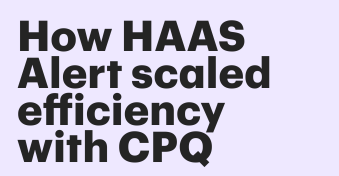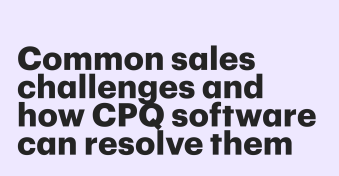A sales proposal serves as the foundation for aligning expectations, outlining terms, and advancing deals. On average, sales reps can spend between 5 and 20 hours a week preparing proposals.
When proposal creation is slow or inconsistent, it can stall momentum, delay decision-making, and cost your team valuable time.
That’s why sales proposal automation is a must-have for successful, high-velocity sales teams.
Learn more about sales proposal automation, how it works, and the tools you need to close more deals fast.
What is sales proposal automation?
Sales proposal automation is the process of using software tools to optimize the creation, sending, and managing of sales proposals.
Sales proposal automation reduces manual tasks and admin work, helping reps create and send error-free proposals faster, accelerating the sales process, and helping you close more deals.
Many tools also include personalization features, tracking, and internal collaboration workflows to streamline the process and improve win rates.
Proposal software like PandaDoc integrates with your CRM and other tools in your tech stack to help you centralize proposal creation, document generation and management, and eSignature, so your team can get more done in a single platform without constantly switching between platforms.
The benefits of automating sales proposals
Sales automation tools help your team get more done in less time. This enables representatives to shift their focus from tedious administrative work to more high-value activities, such as building and nurturing customer relationships.
Sales proposal automation helps teams:
Work smarter, not harder
With features like pre-built templates and pricing tables, sales automation tools simplify and speed up the proposal creation process.
But creating the proposal is only the first step; what about getting the right stakeholders to approve it before sending?
Sales proposal automation tools, such as PandaDoc, include approval workflows that allow you to create a signing order and set up reminders and notifications to streamline the review process.
Improve consistency and accuracy
Gone are the days of creating quotes and calculating prices in spreadsheets. Ditching these manual, error-prone methods helps your sales team create accurate proposals in less time.
Proposal templates ensure you have the right formatting and necessary components to create consistent, professional-looking proposals every time.
Enhanced collaboration
If your team collaborates on proposals via Google Docs or long email threads, there’s a better, more efficient way.
Sales proposal automation tools allow multiple team members to work on a document in real time.
That may seem chaotic, but features like audit trails, content locking, and version control prevent mix-ups and accidental edits.
Your team can work together confidently, all in one place.
Gain valuable insights
Sales proposal automation tools provide tracking and analytics that show you when a proposal is opened, how long recipients engage, and whether it’s been forwarded or signed. This helps your team get a clearer picture of what’s resonating with prospects–and what’s not.
Stop guessing and use data-driven insights to make edits and adjustments to win more deals and improve close rates.
Common challenges with manual proposal workflows
Manual workflows are outdated and can lead to inefficiencies in sales and business operations.
Here are some common challenges teams experience with manual processes.
Human error
Even the most careful sales reps can be prone to typos or data entry errors. And when you have multiple collaborators and approvers, it leaves the door open for additional human error.
Approval bottlenecks
Waiting for stakeholders to check their email or sign off on a proposal can cost teams valuable time and money.
Even after the proposal is sent, following up manually with a prospect can be time-consuming and lead to further delays.
Data inconsistencies
If your team is creating a proposal in one platform and pulling in customer data from another (like your CRM), this can lead to mistakes or inconsistencies. Proposal automation tools enable data synchronization between platforms, allowing you to avoid errors that occur when using disparate systems.
Lack of version control
When multiple team members manually edit the same proposal—especially across different platforms or email threads—it’s easy to lose track of the most up-to-date version. This can result in miscommunication, conflicting terms, or even sending the wrong version to a prospect.
Inconsistent branding and messaging
Without standardized templates, proposals can vary significantly in terms of formatting, tone, and branding. This inconsistency can make your team look unprofessional and damage credibility, especially when proposals are being reviewed alongside competitors.
What to look for in a sales proposal automation tool
Automation tools can speed up the proposal process, reduce errors, and save your team time and headaches.
Here are some essential features to consider when evaluating tools.
Easy-to-use document creation and editing
First and foremost, you want a tool that’s easy for your team to use. What’s the point in saving time on proposals only to trade that for teaching your team a complex tool?
Look for tools with a drag-and-drop editor and content library to save layouts and branded assets for fast document creation.
Pre-built templates
Why create proposals from scratch when you can start with a professional template and customize it for your client?
Take the guesswork out to ensure all the necessary components are included.
Electronic signatures
Don’t add another tool to your tech stack. Proposal automation software with built-in eSignatures lets you create, send, and sign documents without leaving the platform.
Collaboration tools
Ditch Google Docs and upgrade to a tool with collaboration features like redlining, contract automation, content locking, and approval workflows.
Team members can work together on the same proposal without worrying about unauthorized edits.
Platform integrations
Look for proposal automation tools that sync with your CRM to keep customer data in one place, as well as any document management tools your team uses.
Analytics
Understand how your proposals are performing so you can make data-backed adjustments and improvements. Most proposal automation tools include analytics and reporting features to let you track performance metrics and understand recipient behavior.
How PandaDoc helps automate sales proposals
PandaDoc helps teams move faster by automating repetitive steps in the proposal creation process.
Here’s how:
- Pre-built templates: Use customized, reusable templates to save time and ensure consistency. Fields like recipient names, price, and dates can be auto-filled from CRM data.
- Automated approval workflows: Set internal approval steps and signing orders to route documents to the right managers based on deal size or type. Everyone knows when it’s their turn to review—no chasing down signatures internally.
- Document tracking: Get real-time notifications when a document is opened, viewed, or signed. See which pages the recipient spent the most time on.
- eSignatures: Built-in, legally-binding eSignatures included with every plan. Recipients can sign from any device—no downloads or accounts needed.
- Integrated payment collection: Add payment options (like credit card, ACH, or PayPal) directly to your proposals so clients can sign and pay in one step. Automate follow-ups and reduce time-to-cash by closing deals and collecting funds in the same workflow.
- Reporting and analytics: Track sent, viewed, and signed documents across teams. Measure turnaround time, close rates, and template usage.
CRM integrations
PandaDoc integrates directly with major CRMs to pull data into documents and push updates back automatically. This cuts out manual work and ensures accuracy.
Salesforce integration
- Create and send PandaDoc documents directly from Salesforce.
- Pull in Salesforce fields (like contact info, deal size, or product data) into your templates.
- Document status updates sync back to Salesforce automatically.
Learn more about our Salesforce integration.
HubSpot integration
- Build and send documents straight from HubSpot’s contact, company, or deal records.
- Auto-fill templates with HubSpot data like names, company info, and pricing.
- Track document activity from the HubSpot timeline.
Learn more about our HubSpot integration.
Pipedrive integration
- Generate proposals and quotes from a deal view in Pipedrive.
- Map deal details like client name, value, and products into PandaDoc templates.
- Sync document activity back into Pipedrive so the sales team stays in the loop.
Learn more about our Pipedrive integration.
PandaDoc CPQ can enhance your sales process even more, especially when you’re dealing with complex products or variable pricing.
What PandaDoc CPQ adds:
- Product catalog integration: Build and maintain a dynamic catalog of products and services with pricing, descriptions, and SKUs.
- Guided selling tools: Help reps configure quotes quickly with dropdowns, checkboxes, and pricing logic that ensures accuracy.
- Real-time quote building: Reps can drag and drop items into a quote, and everything updates automatically.
Beyond our CRM integrations, PandaDoc offers CPQ solutions for Pipedrive, Salesforce, and HubSpot.
Avantio, a software and professional services company, started using PandaDoc to create and send proposals faster, resulting in a 200% increase in sales within a month.
“Previously, we used ancient software that just didn’t provide the user-friendliness and efficiencies we needed to better serve our customers. PandaDoc was the clear winner because it easily integrated into our existing systems and provided us with a way to sell our broad scope of services to customers and boost sales. Our customers’ experience is our top priority, and building trust with them is critical. PandaDoc helped us up-level that experience by simplifying our processes and enhancing how we communicate with our clients.”
- –Marija MišeCustomer, Success Manager at Avantio
Simplify the proposal creation process and close deals faster with proposal automation
Help your sales reps excel in their roles with the proposal automation tools. Make proposal creation simple and fast, automate the approval process, track recipient behavior, close deals, and collect payments from one easy-to-use platform.
Ready to see how PandaDoc can speed up and simplify your sales process? Contact us to schedule a personalized demo.
Frequently asked questions
-
PandaDoc integrates with top CRMs, including Salesforce, HubSpot, and Pipedrive to simplify and accelerate sales workflows.
Through CRM integration, PandaDoc can:
- Auto-fill documents with contact, deal, and company data
- Sync document status updates directly in the CRM
- Allow sales teams to track proposal progress without leaving the CRM
-
Yes. PandaDoc offers real-time proposal tracking, including:
- When a proposal is opened
- How long recipients spend on each page
- The exact time it’s signed or completed
-
Yes. PandaDoc is secure and legally compliant.
It ensures:
- Encryption of all documents
- Audit trails to monitor all actions
- Legally-binding eSignatures, compliant with ESIGN and UETA standards
Disclaimer
PandaDoc is not a law firm, or a substitute for an attorney or law firm. This page is not intended to and does not provide legal advice. Should you have legal questions on the validity of e-signatures or digital signatures and the enforceability thereof, please consult with an attorney or law firm. Use of PandaDoc services are governed by our Terms of Use and Privacy Policy.

